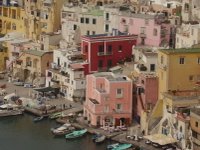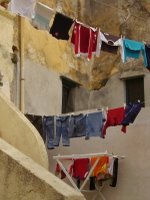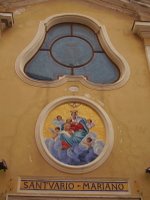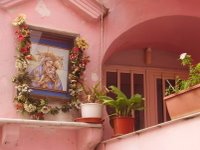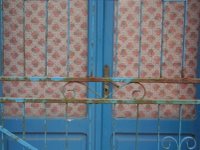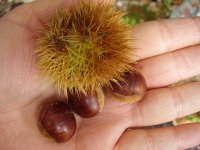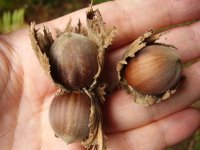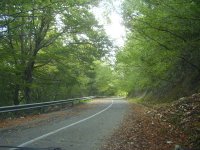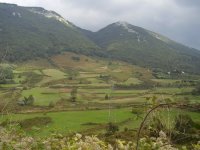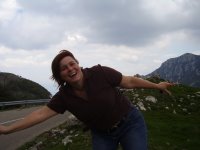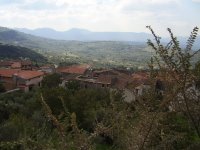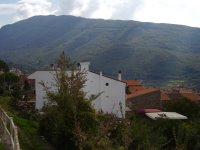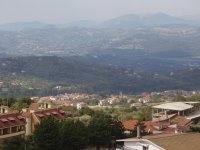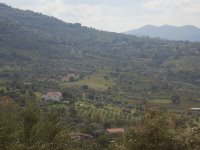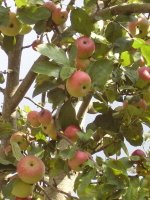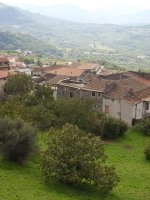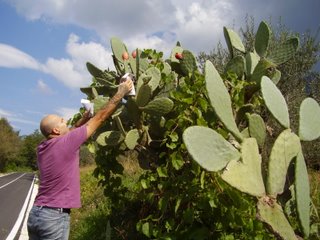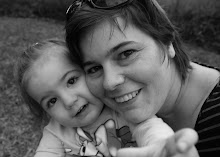The Minister of Justice is considering sending in the army.
The newspaper headlines read 'Naples at War'....with itself.
The BBC news has been reporting the recent developments in Naples.
Tuesday 31 October 2006
Nine Dead in Nine Days
Monday 30 October 2006
Second hand, no fakes!
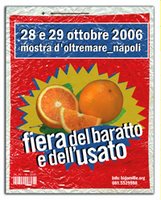
Second hand and used but no fakes! That's what the poster promised. A weekend fair of antiques and secondhand goods at the exhibition grounds in Naples. After forking out Euro 14 to get in (truly exhorbitant) we spent several hours wandering around the stalls. Vendors were selling just about everything you could imagine from CDs, Star Trek figurines, antique furniture, handmade crafts, second hand cowboy boots, jewellery, coffee grinders, paintings...a true treasure chest. We could have easily spent a lot of money but resisted the temptations. However, once we decide to return to Brisbane it would be amazing to buy some Italian linen, 70's kitchenware and art to bring home. Gi was looking at guitars, drums, a saxaphone, pasta makers ....
Wednesday 25 October 2006
Robbie's newie
You should know that I am still living without access to the television. But that doesn't stop me from staying up to date with Husband No 2 (to be) Robbie Williams. Here's a link for the video to his new single Lovelight...deep sigh inserted here.
http://www.youtube.com/watch?v=qtq3yHWNZaA
Train graffiti

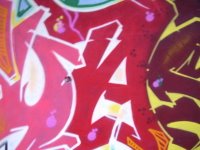
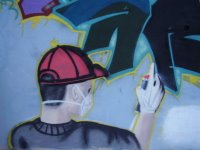
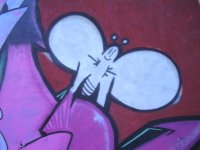

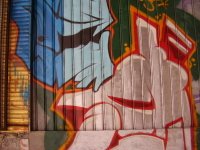
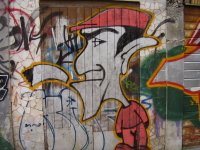
Postal service?
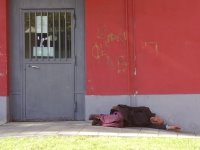
Let me tell you a little story. It's about this photo. This is a photo of one of our friendly neighbours. He often sleeps in this spot.
The local community has organised a protest for it to be reopened but to no avail.
Tuesday 24 October 2006
Exam boredom
I’ve finally finished marking 20 exams. It’s the first pile in this my new PT teaching career, and I’ve already decided not to give the students any more exams. It’s just too tiresome. Never mind the inlingua policy of testing students after every fifth chapter in the text book!!!
Inlingua usually has class sizes of no more than six students. The problem is that this is a government class with 25 students in it, and I only get paid for my in classroom time. Marking exams and lesson preparation is all on my own time…which means that my motivation is decidedly lower. After some discussion with other teachers I realised I was marking the exams too strictly, and probably need to think of the process as more of an indication of their progress. (The fact that Italians are programmed to cheat quite blatantly is another problem that makes exams somewhat counter productive).
By the way, I don’t want any feedback from all the other teachers in my life who think I’m complaining…I know, I know it’s the same for all teachers around the world. But really, marking exams, what a bore!!
Sunday 22 October 2006
Procida Island
Daylight Mugging
Relax, it didn't happen to me. But it certainly had an impact nonetheless.
I was standing at the bus stop yesterday afternoon, across the road from where we live. I was waiting for a bus, on my way to school. I stood there, quietly observing the women complaining about the delayed buses, gesticulating and posturing as if to say 'It's Naples, what more could you expect?'
Beside me stood an elderly gentleman, and after some minutes I decided that he was probably a tourist. He was taller than me, thin greying hair, and rather pale. He was dressed in cream corduroy trousers and a cream long sleeved shirt, with a tan leather bag slung across his chest. He kept checking the bus stop sign and didn't speak to anyone. He would have been in his late 70's.
Suddenly the crowd around us started screaming and flapping around like a flock of pigeons startled by a toddler. Unfortunately it wasn't a toddler. A young man in a pale blue sports jacket had run up and grabbed the elderly gentleman by the arm. He was attempting to unfasten his watch and slip it off his hand. The man turned to face his assaliant and started struggling. At the same time I was afraid that another guy might come from the other direction to grab his bag, so instinctively I grabbed the gentleman from behind to hold his bag. Of course then he started to panic that he was also being attacked from behind.
Unable to simple remove the watch, the mugger resorted to ripping it from his wrist, the metallic band breaking in the process. Then he was off. It happened very quickly, yet I felt like I was watching a movie in slow motion. After the mugger took off, the gentleman turned to face me, shaking me off, distancing himself, looking around wildly. Quickly I began to apologise, realising my reactions had caused him further distress. His wrist was cut and bleedly heavily, and suddenly we were surrounded by 'concerned citizens' who had just moments before stood there watching, failing to stop or restrain the mugger in action. People started lamenting about the city and it's petty criminals, how it was such a pity. 'Would you like a tissue?'. 'What did he take?' 'Oh, a watch, of course, a watch. Was it a good one?'
Yes it was a good watch.
After a brief pause, having answered a few of the questions in Italian, I turned to the man and asked if he spoke English. He was clearly not understanding the conversation circling around us. He did speak English. He was Spanish. He was taking anti coagulation medication which explained why his wrist contintued to bleed profusely. I apologised again for grabbiing his bag, explaining my actions had been instinctive and protective having myself been the victim of a bag snatch.
Slowly we began to talk. He was clearly shaken up. His hotel was at Piazza Garibaldi, and he managed a laugh when I commented that that was the dodgiest part of Naples. Ironically he'd had his wallet stolen the day before. And having spent two hours at the police station he'd missed out on his scheduled visit to the National Archeaological Museum. So, while his wife and their travelling companions went up to the Royal Palace he'd been to the museum...only to get mugged on the way back to the hotel and have his watch stolen.
I was taking the same bus, going to Piazza Garibaldi, so boarding the bus we continued talking, about my work, the local people, their plans to visit Sorrento next. He thought I was American, and after telling him I was Australian he admitted he had difficulty hearing the difference between the two accents. I explained that many Neapolitans assumed I was Eastern European, but I thought that was largely because of my hair colour. He denied that I looked at all Slav, claiming they had small heads in comparison to their bodies, and that I was certainly more beautiful than the Neapolitan women.
As the bus travelled towards the piazza, through the traffic, he started to relax and breath normally. His wrist had stopped bleeding and while he was still upset he explained that he mostly objected to violence of the attack. He could see the beauty of the city with its art, architecture, history and cuisine but admitted that he would be warning his friends not to visit Naples. Understandably, he was mostly concerned that he could have been pulled down, falling onto the ground, and could easily have sustained a broken bone. I agreed that the muggers seem to target older tourists, those that are less likely to give chase or put up a fight.
Upon hearing the story, Gi himself voiced his wish that he had been there as he certainly would have reacted better than those standing around us...the scared pigeons. Gi himself encountered a victim of watch mugging some weeks ago. They brazenly conduct these attacks in broad daylight, in busy streets. The middle aged female foreigner didn't initially realise he'd stolen her watch, it happened so quickly.
As we disembarked, the gentleman thanked me for my help and soothing conversation, then headed towards his hotel. I headed across the piazza, dodging cars, buses and undesirables making me way to my connecting bus to work. It was only then that I started to feel a bit shaky, realising that the mugging had happened right beside me, in my neighbourhood, in broad daylight. The strangest thing though was that none of the people waiting with us a the bus stop had done anything to stop it.
However, like much of the petty crime that takes place in Naples it's like water off a duck's back. These people come to expect this sort of behaviour from a small minority amongst them. Yet, somehow, I feel that it is there inaction, and unspoken acceptance that allows this network of criminal activity to continue unabated. Until the neighbourhood stands up, and people start to take action instead of just vocally lamenting about the inevitability of it, nothing will change. This is the essence of Naples' underbelly of sadness and apathy.
Sunday 15 October 2006
School Views
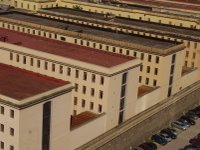
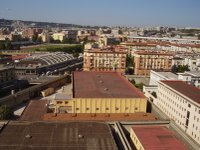
13 October 2006
I’m sitting in the staff room at the Inlingua School in the central business district, Centro Direzionale. It’s 5.30pm, late afternoon. As I look at the window I have a 180° view of the city. Directly below is the prison, a bulking complex of cream and yellow rectangular buildings with flat red rooves. Small windows uniformly dot the walls. I occasionally spy a guard strolling around the top of the perimeter wall. They never look particularly vigilant. I believe that this prison is merely a holding area, as court procedures are finalised and prisoners assigned to permanent locations for incarceration.
To my right is a mirrored skyscraper, reaching up into the smog laden sky. The afternoon sun is glinting erotically off what must by the 15th floor, some two levels above me. As the afternoon wears on the sun moves on to its next target and the building changes colour, first gold merging into aquamarine, then bronze mixing with an olive.
On the opposite side of the expansive window is the sunset. The apricot haze melts into the pollution that habitually settles over Naples after a clear, dry day.
The airport is located in the centre of Naples and from here we can watch the planes take off. It almost appears as though they are taking off from a patch of wood, flying out of the trees at a sharp angle. It’s even stranger watching them land, the planes diving into the city.
One of my colleagues has just booked his flight home, and I’m thinking that Gigi and I need to finalise our Christmas plans. We are hoping to train north with his mother and sister to visit other family. After the ‘strain’ of Christmas I think we might jump on a plane from Venice and head off somewhere for New Years. We both need some sort of mini break to look forward to, and with both the school and the clinics closed for that period we might as well enjoy the time off.
Centro Direzionale is a suburb that has a modern urbanite edge to it, but is tainted with controversy, gangster money and now government incompetence. It was planned by the Japanese architect Kenzo Tange in 1982 after some twenty years of bureaucratic indecision and delay.
“The skyscrapers of the Centre, even if they are not among the tallest ones, stand out very much from the fabric of the city (mainly horizontal) and are perfectly visible from each point in Naples”, as quoted on a Naples website. Ironically one of these skyscrapers stands burnt out and empty following an attempt at insurance fraud. Some 25 years after its completion many locals now consider the CDN an eyesore, out of context and lacking in character.

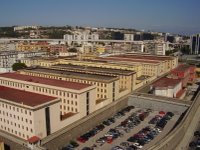
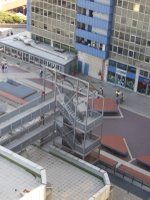
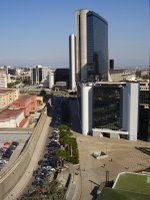
Thursday 12 October 2006
Mountain Dream
Sunday drives. There is something romantic and special about driving out of the city on a Sunday, especially in Italy. Sunday drives are not the cultural norm in this country, at least not in Naples. Traditionally, Sunday is the day when families gather around the table, to enjoy a late, lengthy lunch. And the aftermath: animated discussions, unbuttoned jeans and a wave of lethargy caused by indulgence. Any idea of wandering around the countryside, cruising and exploring simply because you can would, in fact, strike some as the strangest way to spend the day.
Yesterday we took a Sunday drive. Borrowing Rosa’s car we drove north, taking the freeway out of the city, leaving the Sunday morning bustle of religion, pavement socialising and Sunday lunch market shopping behind.
Heading off the A1, which would otherwise take us to Rome, we skirted around Maddaloni, taking the No. 265 through Dugenta before turning right towards Melizzano. The road now started the series of twists and turns that would take us up, up into the mountains.
From a city like Naples, throbbing and heaving with intense energy bordering on chaos, you escape to one of two places; the coastal beaches and islands or the mountains. Delightfully, the region of Campania is a treasure trove of both, and more. As we drove Gi lamented the fact that Campania, as a whole region, continues to be a largely undiscovered area.
As with all things in life this means that it is relatively easy to escape the tourist crowds of the ‘known’ pockets of Pompeii, the Amalfi coast and the isle of Capri. The other side of the coin is that, unlike Tuscany, it fails to attract the attention of travellers and misses out on the associated economic, social and cultural benefits. Similarly, increased tourism could bring more refuse, traffic and environmental damage. But sometimes, as in Tuscany, tourism promotes a level of pride in a particular area which sees improved services and a focus on environmental sustenance that might otherwise be neglected.
We drive deliciously close to Solopaca, a community well known for its wine production, but that’s for another Sunday. Instead the road curls around the side of the mountain and soon we float through Frasso Telesino, a mere red dot and scattering of black specks on the map, but in actuality a charming village.
We pause several times to take in the view, wide panoramas of the countryside falling away below. Houses are strewn across the expanse, like a giant child has tired of his toys and walked off outside, scattering them in his wake. White walls and red rooves are in the majority, but it’s the occasional and unexpected splash of apricot, yellow and orange that draws one’s eye.
However, it’s the traditional farmhouses which catch my imagination; some lovingly renovated, others stand abandoned and derelict. I always want to stop and knock on the door, my knuckles causing some of the fading blue paint to peel and flake away. As we drive by I can’t help but peer into open doors and windows, catching glimpses of people’s lives. Women don housedresses and flowery aprons, short wavy hair greying at their temples, as they sweep floors, string beans, fold sun warmed laundry or wait for the coffee pot on the stove, already enjoying the headiness of the caffeine from the aroma alone.
The men that I spy never seem to be as gainfully employed. They sit by kitchen tables waiting for that small china cup to deliver the hot, dark drink already sugared and stirred just as they like it. Maybe they sit out the front of the house, occupying a well worn chair, watching the trickle of passing traffic. Or more energetically they tend to vegetable patches and inspect grape vines as the sun slowly ripens the small orbs of fruit. With time cloudiness settles on the skin which is neither black nor purple in colour.
The valley reflects the agricultural heritage of the area, plots of green, lines of olive trees and fruit trees like little groups of soldiers on parade. The season is over, but in some plots corn lingers, drooping with the weight of unpicked cobs, the leaves and husks pale, crisp and papery. We pass open sheds, with leaves of dark brown, the colour of shoe leather, hanging in neat orderly rows. In due course I recognise it as drying tobacco, and can only wonder at its end use as the quantities seem hardly enough to be for commercial production.
It’s autumn and that means apples and pumpkins. Along some strips of road it seems that every private home has apple trees. The thin branches splay out; some are loaded with green leaves and the rosy apples. Others are stripped of nature’s bounty, with the apples laid neatly on the ground, bedded on top of hay for further ripening. Most of these homes have a little hutch set up out front, or perhaps it’s just a barrow with loaded fruit boxes and buckets. The apples look pretty in the morning sun. However, the enormous pumpkins stacked one on top of another in descending size look proud and removed from the people stepping out of cars to buy fresh, organic produce from little old ladies in dark stockings and sensible shoes. I want to stop and photograph these little wooden stalls and piles of grey skinned pumpkins, as they look like something out of a children’s story book, but by the time I’m ready the last of the stalls is behind us.
Instead I take to photographing the real thing, apples adorning trees in a small orchard by the side of the road. Gigi takes to raiding. Initially he has pulled over unexpectedly at the sight of a prickly pear, its fruit glowing red and enticing in contrast to the large, flat stems. He scrambles around for something to protect his hands, and settling on some paper stretches up, leaning perilously close to the cactus’ spiny paddles to reach the fruit. I’ve never eaten Indian figs (as they are also known), it’s a menace in Australia, and he’s delighted that I’ll get to sample it.
In the meantime I’ve wandered up the road to take a closer look at the apple orchard. I’ve discovered something even better and Gigi is soon clambering up on the bank of rich soil to pick fresh figs, speckled amongst the broad flat leaves. For good measure he also helps himself to some apples, secure that we are out of view of the nearby farm house, although the sound of barking dogs soon drives him back to the car.
Once buckled up, I try one of the apples. They are small, their size undoubtedly making them unsuitable for sale in a supermarket, but the first bite reminds how an apple is meant to taste. The sharpness fills my mouth, crispness mixing with the sweet, tangy juice. It’s as though I can almost taste the colours too, the cherry red melding with the pale green of the skin.
The figs are still green on the outside, but some of them are ripe to the touch and we split them open to reveal the luminous dark pink tentacles, tipped with white, inside. There is something very special about eating fresh, fresh figs. They are almost impossible to buy, but sometimes we stumble across an unlikely looking rotund man selling figs from a wheelbarrow, on the street corner. Most commercially grown figs are dried, canned or candied and following these processes I lose interest. The fresh fig has something of the Garden of Eve about it. Its freshness and edibility is a fleeting thing, too much handling and it’s lost. It’s a fruit of the moment, best enjoyed while standing in the shade of the tree’s low deciduous branches.
The views drop away and we drive through a small lush valley. A craggy mountain looms on the left, parts of the forest vegetation interrupted by bare grey rock. A sign declares that we have now entered the National Park of Mount Taburno, and we begin to climb again. The atmosphere changes and I feel decidedly cooler, yet resist the urge to wear my jacket. We both relish the change of temperature, it makes us feel like it really is autumn after the unseasonably warm October days in Naples.
Soon we are surrounded by autumn. The national park is enchanting. The deciduous trees are in that lovely phase where the beckon the change of season. We drive through groves, mottled grey tree trunks slender and confident unfettered by branches until well over head height. Small green leaves decorate the trees, with the odd flash of gold. Most of their companions have already fallen, and the ground is hidden by a blanket of dying leaves. There is a complete lack of undergrowth vegetation, so the rust floor, grey trunks as the focal point, and canopy of lime creates a strangely beautiful image, both tranquil and mysterious in its uniformity and openness.
Further along we drive through a natural archway. The trees are different with low spreading branches and spindly scrub reaching out to greet us. Damp moss crept over rocks and exposed root systems. The sunlight is filtered, dappled; the trees making a gallant effort to prevent us from seeing the hazy sky above. The road is clear, a solid white line guiding the way but its edges are awash with the casualties of autumn. We stop to breath in the underlying dampness of the shady woods, and crunch over piles of leaves, their colours leaping up in contrast to the asphalt. A closer study reveals a myriad of colours underfoot: russet, tan, bronze and copper, mahogany, flaming orange, amber, cool yellow and slate grey.
The area is largely inhabited. We pass a couple of private homes, one which looks like a holiday escape, its dark green exterior attempting to hide its very presence. Another villa is nestled on a hill to the left of the road, obscured by vegetation, but the ‘For Sale’ sign gets us wondering at the local prices. We also notice a hiking refuge, a depressed restaurant that looks closed and a small hotel with a sweeping car park to match the views. We pass only a few cars. Some are stopped as people painstakingly pick blackberries, tramp over layers of leaf matter along walking trails or pause to eat lunch at wooden picnic benches.
We breathe deeply, enjoying the clarity of the air, reconnecting with an environment that isn’t polluted from vehicular fumes, factory output and the presence of several million people. Unfortunately much of the native fauna has disappeared, but we do hear the trill of unidentified birds, and the cling clang of bells hung around the neck of wandering cattle.
Twice Gi stops to pick chestnuts. Initially we pull up beside a corrugated shed, with window shaped holes cut out and fading petrol sign peeling on the front. Another hand painted sign in navy blue and crimson has arrows pointing left and right, providing directions for lost visitors. Oddly there is a fireplace inside. The shack is hardly big enough for a table and chair, but there stands a red brick fireplace, as though it is ready to provide warmth at a moments notice. The space is littered with refuse, which I find both repulsive and sad.
Gi hops around looking for chestnut pods that are yet to spill their nuts. The pods are green-yellow and covered in prickly spikes. If you step on them carefully you can ease them open without risking fingertips, bend to prise out the chestnuts. Across the road, beside the shed, he spies a hazelnut tree and we crack open a couple of nuts that are edible.
At another bend in the road Gi again pulls over and we spend some time working our way along the road, filling a plastic bag with chestnuts. The road is awash with squashed pods, the nuts a crumbly mass on the bitumen, the spikes no match for car tyres. I find dealing with the barbed pods a painful exercise and take to looking for chestnuts on the ground, careful to check them for the microscopic holes indicating worm infestation. Gigi is very excited, already anticipating the process of toasting them under the grill at home before eating them like a popcorn snack as we watch a movie. To his dismay I find chestnuts generally unpalatable, very mild in flavour and too pasty in texture, although I suspect he’s secretly pleased that he gets to eat even more as a result.
We see a sign for a fresh water spring and turn to investigate. These signs rarely have any distance indicated on them and after driving for some time we stop to study a colourful tourist map on the side of the road. As we try to work out how much further it is to the springs Gi notices the sign is riddled with bullet holes. The large ‘Siamo Qui’ (We are here) indicator is surrounded by the disturbing marks and we turn to return to the main road.
Having entered the mountainous national park on the north western side we exit on the south eastern corner, skirting most of Montesarchio before taking country roads to San Martino. We bypass Pannarano and marvel at a gorgeous villa that has been converted into a private dentistry practice. We are now on the northern edge of another regional park, but drive through the valley to Rotondi, a small village Rosaria recommended. It’s quiet, and pretty in the historical centre, with a train station that would be convenient for the commute to Naples. The main activity on this lazy Sunday afternoon is happening at the local bar, the old men of the neighbourhood have gathered for aperitifs over card games and loud political discussions.
After half an hour of trying to get the street signs and map to correlate we find ourselves on secondary road No 162. This takes us through Acerra, once a distinct town, now a border suburb of the swelling Neapolitan metropolis. This is a place that struggles, with crime and ignorance. The rubbish is piling up on the streets as the garbage collection strike continues. The sweet aroma of cool forests is soon replaced by the offensive odour of smouldering, toxic gases released from the plastics as the locals take to burning the rubbish in an attempt to eliminate it.
We have driven less than an hour from city to nature and it’s as though we’ve travelled to another world. We both hope to visit on another Sunday drive soon. In the meantime we are dreaming up ways to combine country living with city based work.
Sunday 8 October 2006
Parents in Pompeii
This is an extract from my summer story. We visited Pompeii with Mum and Dad on 3rd August 2006
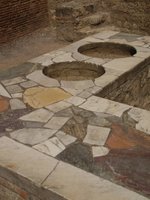
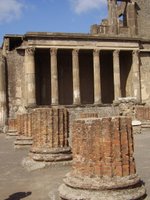
Leaving early we drove down Via Duomo, a wide well paved road lined with bridal shops, fashion boutiques and shops selling religious artefacts, garments and equipment. Turning left onto Via Nuova Marina, we followed the cobblestone road along the edge of the bay passing some of the uglier parts of the port with shipping containers, neglected buildings and seedy looking corners. Bumping along the road, crammed in between peak hour morning traffic, tour coaches and trams my parents held their breath, struggling with the Neapolitan style of driving. Gigi confidently zipped in and around the traffic and pedestrians, taking the freeway exit guiding us over the crush and commotion below. Driving on the freeways is another skill set, as loaded trucks tailgate, cars wander between lanes (mobile phone usage is responsible for a lot of distracted driving in this country), and expensive cars race by disregarding speed limits and general safety.
The morning was spent exploring the world’s most famous volcano disaster site, Pompeii. With 2.3 million visitors each year it’s Italy’s top tourist attraction, and with an average of 6500 tourists a day it can be as busy as the ancient streets must once have been.
In retrospect the locals should have suspected the volcano was restless when an earthquake struck in 62 A.D. Despite this preliminary warning and devastation Pompeii was quickly rebuilt and was a dynamic commercial centre, with market goods and people arriving from nearby villages when the volcanic eruption of 79 A.D. completely demolished Pompeii and the neighbouring towns of Herculaneum and Stabiae.
Pompeii lies a few miles south of Mount Vesuvius. The volcanic eruption buried the ancient city under layers of lapilli (burning fragments of pumice stone), volcanic sand and ash. It’s this combination of ashes mixed with rain that formed a hermetic seal around the city, preserving many private dwellings, public structures, shops, baths and temples. Surprisingly the city lay buried and undisturbed for some 1500 years and in 1748 excavations commenced. New discoveries were made in the 19th and 20th centuries, and a whole frescoed leisure area unearthed in 2000. It’s estimated that a quarter of the site is yet to be excavated.
Surprisingly, most of the city’s 20,000 inhabitants escaped the destruction carrying their personal belongings. However, some 2,000 people perished, either under rooves that collapsed as a result of the weigh of the burning stone, or from the poisonous gases released by the volcano.
One of Pompeii’s most enduring images is that of the body casts. The rain of ash and lapilli smothered those that didn’t manage to escape, including gladiators and slaves that were chained up; forming moulds that remained after the bodies themselves had decomposed. In 1870 the excavators filled these empty cavities with liquid plaster, thus preserving the exact forms of the bodies at the moment of death.
Many of these body casts are now housed in Naples at the National Archaeological Museum but there is a group of family members, struck by suffocation and fear, in an area of Pompeii now known as the Garden of the Fugitives. Entering the garden I was struck by how pretty the vineyards and imposing Mediterranean pines were in contrast to the surrounding dusty ruins. As Gigi scoured the fig trees for fruit Mum inspected the unripe bunches of grapes. However, the family of bodies, now stored in glass cabinets, is an eerie reminder of how terrifying the volcanic explosion must have been. Huddled together, the adults and children exude a level of panic we can’t possible imagine. The details of the facial expressions, exposed teeth, hands thrown over heads, curled up in foetal positions waiting for the end, are chilling and left me feeling disturbed.
The ancient Pompeii was enclosed by a wall with eight gates. We entered the site through the Porta Marina gate. Interestingly, this had been the south western sea gate providing convenient access to the town centre from the Bay of Naples. The eruption of 79 A.D. raised the sea beach and the course of the River Sarnus (now Sarno), placing the river and sea at a considerable distance from the ruined city.
Having arrived early we largely managed to avoid the tour bus groups that rush around the major points of interest over a short period of time. Walking along the pathway we passed the Temple of Venus, once one of the most lavish temples. It was still being repaired after the earthquake of 62 A.D. when the volcanic explosion buried it. Its exposed position meant the temple was severely pillaged, and it now sits in a terribly disappointing state.
As we strolled around the streets of Pompeii we admired the paving. Large flat stones, irregularly shaped, lined the roads edged on both sides by deep gutters and high footpaths. Remembering that the Pompeii we were exploring was an Italian provincial city of the 1st century A.D., imagine the work involved in sourcing, cutting, transporting and laying the stones to form amazingly solid, even roadways. Large square blocks are found at intervals along these roads, effectively connecting one footpath with another. These were used by citizens wishing to cross the road, especially when the streets were wet and muddy. I was particularly taken by the furrows carved into the paved roads by the wheels of carts. The tracks were most evident around the stepping blocks, and I found myself visualizing the horse and carts lumbering through the streets. Such images were further enhanced by the tethering rings still hanging from walls outside shops and homes where horses and pack animals were once tied up.
The only area closed to cart traffic was the Civic Forum. The foro, a large rectangular square, was a pedestrian precinct and the political, economic, commercial and religious centre of the city’s life. An impressive space, the pale Doric columns and arches offset the ruins of a row of shops and municipal buildings. But it’s the carved columns I love. Faded terracotta in colour, their surfaces pitted from 2,000 years of environmental deterioration, the craftsmanship is still evident in the carving that stands proud and austere to this day. Standing at a variety of heights, some of the columns once supported building structures and rooves; others were the bases for statues. The forum was awash with tourists, poking around, sitting on columns, capturing their memories on a range of photographic equipment, awing at the historical setting in a dozen languages.
Realising it would take days to fully explore the ancient city we decided to focus on only few main places of interest. A collection of structures located near the southern wall of the city near the Porta di Stabia gate. We walked through the Triangular Forum, enjoying the cooling shade of the pines and a striking row of Doric columns before pausing to chat with an English lady. My father and I were momentarily spellbound. With her blonde hair tied back, dressed in white linen, and dark sunglasses she was standing in the shade beside a wall of stone, a frilly white cotton sun umbrella attached to a baby carry backpack. The baby on her back was perfectly protected from the midday sun, snoozing with its thumb tucked in its mouth. A little girl, maybe 8 years old, was hovering nearby, her white shorts and pink shirt highlighting her lovely skin and pale hair like her mother’s. Dad asked if he could take her photo. Graciously agreeing, she was obviously surprised at the request. The picture of English poise, elegance and reserve she portrayed was distinctly different to the backdrop of fading, crumbling relics of a destroyed city in the summer heat.
Beside the Foro Triangolare is the city’s theatre district. A pathway led us up to the top tier of the Grand Theatre. Able to seat 5,000 spectators and originally built in 2nd century B.C. the theatre is a horse shoe shape, in the Greek style, that fits the natural contours of the sloping ground. A charming space, it must have been a delight to sit in the open arena of Teatro Grande on a spring evening watching a theatrical production of Roman times. The Small Theatre (also known as odeion from the Greek) is situated to the left and was constructed about 300 years later. Both theatres had tiered seating arrangements, with the first four tiers reserved for the Decurions. Often operating communally, the theatres staged music, drama, mime, dance and poetry recitals.
Taking in the strange beauty of the theatres we circled around the top tier behind the stage to view the Gladiators’ Barracks. A large open square ground, the barrack is surrounded by a portico of 74 columns and was originally used by spectators during breaks in theatrical productions, or as an extension of the stage. It was later used to accommodate gladiators, as indicated by the presence of cells, service areas, amour and weaponry.
The morning had become steadily warmer. Hats helped shield our faces from the steady beat of the sun, and water bottles were emptied as we then tramped through streets that were once busy with shops and trading. Carved symbols, frescos and fading notices in Latin script sign posted tailors, bakers, restaurants, inn, medicos, brothels and textile production. Most intriguing though were the kitchens and serving counters of the thermopolium, similar to our modern day cafes. Running my hands over the solid marble benches I wanted to know how they had made such flawlessly smooth collages from multi coloured marbles. Towards the end of the bench were two perfectly formed circular holes, used for cooking and serving hot food and drinks. Each bench we saw was an eclectic patchwork of marbles of pale grey, faded burgundy streaked with cream and ruby, a muted blue, saffron yellow shot with dark rose, chalky white with silver veins and a speckled charcoal hue. I wanted to box it up and ship it home for installation in my custom built home of the future.
The south eastern corner of the destroyed metropolis is a green, leafy area where we explored the Anfiteatro and the adjacent Grande Palestra. A long boulevard framed with Mediterranean Pines, their long lean trunks stretching skywards devoid of branches except at the very top where a multitude of branches and needle like leaves seem to burst out like a parasol, guides us towards two of Pompeii’s largest buildings. The Roman Amphitheatre had a seating capacity of 20,000 spectators. Wide arches took us from broad daylight into an ancient corridor, somehow simultaneously dank and dusty. Approaching the end of the tunnel, the glaring light beckoned us as though inviting us into the very heart of the sporting arena that once witnessed gory battles between gladiators and wild beasts. The local communities of Pompeii and Nuceria were such fiercely loyal supporters that in 59 A.D. a violent riot broke out between the fans. The Roman Senate then decided to close the amphitheatre for the next ten years.
The Grande Palestra is a large gymnasium and athletic field, surrounded by a wide columned verandah on three sides. A swimming pool in the centre, 35 metres in length and with a progressive depth, was filled by the public aqueduct. These facilities were built to house the young men’s association, and it was here that they exercised. Unfortunately it’s no longer possible to wander around inside the gymnasium, but even from the outside it was obviously a huge complex. I did however struggle to conjure up that distinct gym smell of fit, young men sweating from their work outs.
Poking our noses through a gate across the gym complex we watched workers tending to a historical vineyard. Oddly an old bath rested upside down by the wall and Dad asked Mum and I to sit on it for a photo. Why? He wanted a photo of us in Pompeii enjoying a Roman bath! Oh, to have the humour of a retiree.
Seeking a break from the crowds and an alternate route we followed Torre VII Road from the striking amphitheatre around the northern border of the site. Unexpectedly we found ourselves in parkland with picnic benches and shady trees providing a pleasant respite from the summer heat. Further along, we strode by small agricultural plots. Ripe cherry tomatoes, protected by shade cloths, hung temptingly from staked plants. Other vegetable crops and legumes were under irrigation. The strangest thing was the complete lack of excavated ruins. It was as though we had wandered off the map of Pompeii.
Next stop was the Villa of the Faun, one of the biggest, most luxurious houses in the highly urbanised city of Pompeii. It’s not known which family owned the house so it’s been named after the little bronze statue of a dancing mythical faun in a pool in the central atrium. The other main feature of the villa is the large polychrome mosaic depicting the famous battle at Issus when Alexander the Great of Macedon defeated Darius III of Persia in 333 BC. Based on a Hellenistic painting, it portrays the soldiers and horses, spears and swords, caught up in a violent, heaving, chaotic, desperate scene. Made up of 1.5 million pieces (brown, black, caramel, tan, grey, white, rusty red and mustard yellow), the original mosaic decorated the floor before being removed and relocated to the National Archaeological Museum in Naples. The original faun statue suffered the same fate. Sadly, the mosaic and statue on display in the Villa in Pompeii are replicas, although both replicas still attracted large crowds as the tour bus groups pushed, posed and pursued the requisite photo.
During the few hours we spent exploring Pompeii we came across two Necropolis, or city of the dead. These monumental tombs were decorated with frescoes depicting events from the life of the deceased or life size statues. The cemeteries of modern day Italy still reflect this cultural preference for burying the dead in imposing house like crypts, families group together, at a significant cost.
With sore feet and grumbling stomaches we wound our way through the eastern backstreets to the Villa dei Misteri. The Villa of the Mysteries is perhaps the best known, and certainly the most complete structure still standing after the earthquake, volcanic explosion, pillaging and World War II bombing. Originally built in the 2nd century B.C. it was renovated during the 1st century A.D. with some of the residential parts converted for agricultural production. The villa is a labyrinth of rustic rooms surrounded by gardens and farming land. In a back room we discovered a large wooden battering implement, carved from a tree trunk with the face of a ram on one end. The strange contraption was used as a wine press. The other highlight of the villa is the Dionysiac Frieze, the most important fresco still on site. Covering three walls of the large dining room it depicts the initiation of a young woman into the cult of Dionysus. The worship of Dionysus, the Greek god of wine, was accompanied by feasts, processions, and musical and dramatic performances and later became occasions for intoxication and gross debauchery. This magnificent fresco portrays a wide variety of frenetic celebrations with priestesses and hand maidens, floggings, drunkenness, phalluses, nudity and adornment, dancing, ecstasy and fear all occurring against the back drop of a red wall.
The ancient city of Pompeii is an extensive site and despite having most of the mosaics, murals, household items and artefacts sitting in museums in Naples and elsewhere around the world it certainly warrants its status as Italy’s most popular tourist attraction. It’s truly magical to wander around a city that thrived some 2,000 years ago and has been so incredibly preserved as a result of a horrifying natural disaster. With a little effort you can imagine the hustle and bustle, the roar of the crowd, the clip clop of horses on the stone roads, the aroma of baking bread, the cries of the vegetable seller and the proclamation of civic notices. As it comes alive you can picture the prostitutes, gladiators, senators, judges, servants and slaves, gardeners, surgeons, fruit and vegetable vendors, tax collectors, women and children going about their day, shopping, worshipping, farming, conducting business, legislating and enforcing the law. Just as we do, in our modern cities today.
Saturday 7 October 2006
Bouffant

My hair is growing. It probably hasn’t been this long since 1996 when I returned from living in London. At the time, my younger sister Kim’s impending wedding and my role as a bridesmaid engendered a sense of responsibility. I’d always observed that before a wedding the brides are always trying to lose weight and grow their hair. Bridesmaids more often than not just commit to the easier option of growing their hair. Apparently it gives the hairdresser more options for the big day. So, in accordance with my observations I found myself following this tradition.
My hair was blonde at the time. The result of this blondeness and longer bob was a bouffant in something of a fifties style. The hairdresser somehow made it look like I had luxurious, wavy hair. Gigi still looks at those photos, cringes and passes a comment that is anything but complimentary. Just between you and me, when I first saw ‘the do’ in the mirror I nearly died, well I nearly cried at the very least. It just wasn’t me. But in hindsight I quite like those photos, capturing the big, blonde, wavy hair of that special night.
I’m afraid of Italian hairdressers. And dentists, but that’s another story. I last had my hair cut in May, while we were in London by my friend Garo. He is a fabulous hairdresser, but short of shipping him over I’m resigned to the fact that my hair is going to get longer. It’s at that terrible stage where my fringe hangs down to the end of my nose. I can tuck it behind my ears but it’s not long enough to tie back. I’m hoping the cold weather comes earlier so I can wear a hat or something on my head to help me through these next few months. However, I am thankful that Garo cut it well which makes the growing out a little less painful.
It does make a girl miss her regular Aussie hairdresser though. Mark, if you’re out there, you are sorely missed.
Classroom
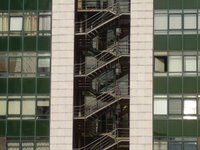
I feel like I’ve just run a marathon. Of course, I’m surmising what it feels like to run a marathon. The closest I’ve ever come to such a feat is to walk quickly…around the block. Although I do recall a cross country run I stumbled through as a teenager. It was part of our high school physical education program. I was not impressed at having to jog up and down hills and gullies and along uneven ground, the long grass catching at my screaming calf muscles, and the sweat gathering unattractively on my upper lip and dripping between my developing bosom, appropriately supported by a B cup sports bra.
But I digress.
I exit the classroom feeling depleted. Flushed, and fatigued. It’s the end of my second week teaching this group. They are all employees of the provincial government, but they come from a variety of departments and office locations across central Naples. This explains why some of them stagger in to class quite late (for a 2:15pm start) and some sneak out early before the 4:45 pm finishing time.
I have discovered today, quite accidentally, that I am working for what is probably one of the best private language schools in Naples. I feel quite lucky that that is the case. They have procedures, a reasonable level of organisation, strong management and support staff and a sound reputation. This might all sound very ordinary to most of you, but here in Naples it’s nothing short of miraculous.
The schools operate as individual franchises, with European headquarters in Switzerland. Switzerland HQ produces the InLingua books for the European franchises. Book 1 is for the complete beginners and by the end of Book 1 the students are expected to have ‘survival’ level English. Book 5 is when you are the equivalent of a mother language speaker. In Naples the schools generally teach Books 1-3. I’m teaching my Provincial group the second half of Book 2.
The school also has a documented policy on class sizes, with a maximum of eight students. There are twenty-five enrolled in my Provincial group. “Why?” I hear you scream. “That’s not fair. You might as well be teaching for Education Queensland if you are prepared to tolerate those conditions!” I hear you lament. The reality is that these government groups are funded by taxpayers, and naturally the government expects value for its dollars (especially when so much government funding just drains away mysteriously…oh, did I just say that out loud?) So instead of a small civilised group, twice a week I’m tackling the equivalent of a rugby league team and a cricket team which explains why I come out of the class feeling like I’ve been through a 2 ½ hour match.
Last week I was, naturally, a bit nervous and quite anxious for the class to go smoothly. Sometime during the early part of this week I decided I wasn’t going to stress, or spend days preparing. To test that theory I went into the class this afternoon with only half the lesson plan documented. I wanted to test my ability to wing it, and I’m pleased to say that no one got hurt, someone might have learnt something and I don’t even think they noticed.
My mother reckons with all the teachers in the family that I was probably born to teach. I’m not sure that that is the case. There is no way I would compare what I do with what my mother, sisters and aunt have done in their teaching careers. Mostly because I, sadly, lack teaching qualifications and feel like a bit of fraud. (Yes, with time that too will pass.) Ironically, while I’m dragging around these quiet feelings of guilt at being (probably) the only InLingua teacher without ‘real’ qualifications I have already received positive feedback. (Perhaps life experience, supervisory training, management skills, an ability to be silly and embarrass myself and significant practice at communicating with my hands, body and facial expressions are all coming into play.) I don’t want to sound immodest, but Katherine (manager) and the receptionist have commented at how quiet my class is. Here I was worrying that we were being noisy, potentially disrupting other classes.
Apparently the school often finds new teachers struggle to control such a big group. It’s requires a bit of juggling but mostly it’s about not letting them get the upper hand.
The school also has a policy that all classes are to be conducted in English. No Italian is to be spoken inside the classroom. This can be a bit tricky but overall it’s the best way for students to absorb a new language. It is also an attempt to get them thinking in the new language as opposed to just translating everything. Of course this can get a bit frustrating and restrictive for some students, and if you known anything about Italians you’d appreciate that getting them to sit and not speak Italian for 2.5 hours is something of a feat. One of the biggest challenges is reinforcing the rule of ‘Only English, no Italian’. The second challenge is maintaining their attention and interest because as soon as they start to drift they break off into individual conversations which become increasingly louder and more flamboyant.
The last twenty minutes of the class are the hardest, and this afternoon I raised my voice at two students (who are both, more or less, my age). There is no way that I can compete with a loud conversation being conducted at the very front of the class, and I made my point in no uncertain terms. Their faces reflected their surprise, and then their shame. Interestingly they both approached me after class to apologise and try to make their excuses. ‘I’m here to do a job’ I reminded them and then tried to explain that culturally I understood that Neapolitans can talk and listen at the same time but where I come from it just doesn’t happen. When someone is talking you shut up, and listen. Their faces reflected an element of confusion, and Gi later confirmed that such a concept is so foreign here that they wouldn’t have understood. In fact it wasn’t until he’d been living in Australia for some time that he truly understood the idea of not talking over the top of other people. In this part of the world though, they just grow up talking and listening and being in the middle of overlapping conversations.
My colleague Seb(astian), is new to Naples, new to real life teaching and a pretty typical young Englishman. He teaches a smaller government group at the same time as my classes on Tuesday and Thursday afternoons. It is compulsory for government employees to attend these English classes. It is part of their work day. They are legally required to sign in and out. Seb’s group pulled a fast one last Tuesday and convinced him that they should finish early. Somewhat gullible, unaware of the employment requirements and the local work ethic (or lack thereof…oh, did I just say that out loud?) he cut the class short. The manager was surprised to see the group wander out some twenty minutes early. Unfortunately it was Seb who received a warning, having effectively been conned by the group.
I think fundamentally he just has a nice face, and a quieter demeanour, and being British he isn’t as comfortable as stepping up to the job of controlling the classroom. More often than not my Australian tendency to be sarcastic and blunt sees me stepping on toes, but in the classroom it certainly helps me avoid being manipulated.
In addition to the challenges of the football scrum group I was asked to give a one-on-one class on Wednesday mornings. The session begins at 8:30 a.m. Now, I initially hoped that I wouldn’t have to teach before 10 a.m. having a natural reluctance to thinking, let alone talking, in the earlier part of the morning. However, this job is not at the school; it is just down the road from where we live in the historical centre. The client is a regional manager for part of the Unicredit banking group. Our first session on Wednesday was in introductory session, and the more he spoke the more I realised I was sitting across from my father. He’s been working for the bank for 43 years. His banking career has seen him transfer every two years or so to another location. Eventually they decided to buy a home in Perugia, in Umbria, one of the provinces they enjoyed living in the most. His home and wife are based in Perugia and he spends the week living in Naples although he does travel to other parts of the south for work. He has grown up children and young grandchildren living in Perugia, Florence and Canterbury in England. He enjoys wine and whiskey, having discovered the delights of quality whiskey during visits to the distilleries in Scotland.
He spoke pragmatically about Naples, picking up the phrase ‘there are two sides to every coin’ that I taught him, using it appropriately to describe a city that struggles with political leadership, traffic and bureaucracy offset against its vibrancy, energy, cuisine and historical significance. I found it quite fascinating listening to an Italian who has an appreciation for Naples. You often find Italians from the north abhor Naples and look down their noses at its chaos, poverty, crudeness and peasant background. While Neapolitans, understandably, are fiercely protective of their city to the point of bias, and consider their northern cousins as blatant industrialists, over regulated and uptight and fail to understand good food and the meaning of life itself. This banking gentleman, Francesco, has lived in the north, the south and looks to be set up to retire in central Italy. Such a balanced view of Naples is something of a rarity, and it was refreshing listening to his analysis and opinions.
6 October 2006: I’ve just received a phone call from the school about another one-on-one lesson. Unfortunately the classes are Wednesday and Friday from 7 – 8:30….p.m. The student is also a complete beginner, which will be challenging. Gigi tends to work until about 8:30pm on Wednesday nights but I’m thinking Friday nights might now become his night to prepare the evening meal. I can see Friday night pizza in my imminent future.
